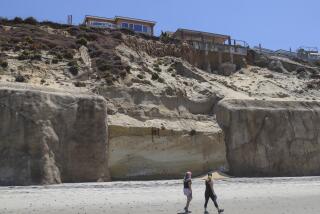Aluminum ‘White Rust’ Plagues Beach Dweller
- Share via
QUESTION: We live near the ocean and, about a year ago, we bought brushed aluminum storm windows to end the cycle of peeling and painting wood-framed windows. I thought we were home free as far as window frames went, but now I notice a white crust forming on the outside of the window frames on only one side of the house. What is this, and what can I do about it? I thought aluminum was an “install-it-and-forget-it” material.
ANSWER: Aluminum is not corrosion-proof. Brushed aluminum storm windows and storm doors form “white rust,” or oxidation, especially in areas near salt water. In case you’re wondering why the storm windows look better on one side of the house than those on the other, it’s because oxidation is worse on the side facing the prevailing wind.
There isn’t too much you can do here, since it’s difficult to paint aluminum. Hardware stores carry an aluminum cleaner that is quite effective at removing the oxidation, although it involves a lot of work. If you’re considering replacing storm doors or windows, aluminum that is anodized or factory coated (typically white) holds up much better than the older brushed aluminum.
Otherwise, you can wax and even apply varnish to brushed aluminum to forestall corrosion.
Patching Jobs Speed Up With Right Compound
Q: We are redoing our walls by patching them and preparing them for paint and wallpaper. It seems to take forever for the patching compounds to dry. Is there any way to speed up the process?
A: Yes. Select your patching compounds wisely. Compounds with a latex base will usually dry within a few hours at most. Patch plaster sets quickly but takes longer to dry. If you use patch plaster to fill deep holes, you can use drywall compound for a smooth topcoat. Very small holes filled with Spackle will be dry enough for priming the same day.
For extensive repairs, use a quick-set drywall compound like Sta-Smooth or Durabond. These will set in as little as 45 minutes. Fast-setting compounds are harder to work with, however. Mix only small amounts at a time and use a plastic pail for mixing. When the job is done, allow the waste to harden in the pail, then flex the sides to break it loose and discard. Keep your tools clean and do not pour compound or wash water down your drains.
Finally, use warm water to speed up drying time or dry the patch with a hair dryer or electric heat gun. If you’re using latex paint, you needn’t wait until the patch is completely dry.
Noisy Water Heater Needs Partial Draining
Q: I have a gas-fired tank-type water heater. Lately, it has been making a rumbling noise after the water has been used and starts to reheat again. That’s the only time it makes that noise. Should it be replaced?
A: The water heater does not have to be replaced. Over the years, sediment, scale and mineral deposits accumulate on the bottom of the heater tank. Manufacturers suggest that a few quarts of water be periodically drained from the water heater to help remove these deposits. However, this practice is not always effective and, if sufficient deposits accumulate, a rumbling or pounding sound can be heard when the unit is firing. It is not a dangerous condition, although the noise can be annoying. Also, the deposits act as an insulator between the water and the flame and decrease the heater’s efficiency.
Wear Layer Helps Protect Flooring
Q: What does “wear layer” refer to with regard to vinyl flooring?
A: As the name implies, it’s the top surface on a vinyl floor. It varies in thickness, often from .005 to .0020 inches, and it’s made of clear vinyl or urethane, the latter being more wear-resistant and more expensive. It starts out as a liquid and is baked on to the sheet of flooring. It’s one of several characteristics that influence a vinyl floor’s cost. The thicker the wear layer, generally, the more expensive the floor.
To submit a question, write to Popular Mechanics, Reader Service Bureau, 224 W. 57th St., New York, NY 10019. The most interesting questions will be answered in a future column.

